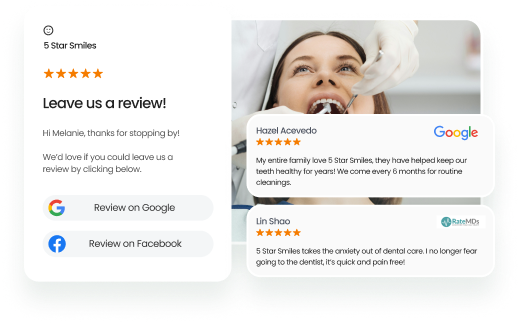Marketing for doctors’ offices has become frustrating for many medical professionals. You’re trained to treat patients, not decode algorithms or build a content funnel. Yet without a proper medical marketing strategy, it’s harder to attract new patients, rank in search results, or compete with larger healthcare providers that dominate digital visibility.
The problem isn’t a lack of effort; most tips about marketing for doctors‘ offices still rely on outdated tactics. This blog will fix that.
Read this blog further to learn nine practical, successful marketing strategies built specifically for multi-location healthcare practices that help doctors grow their patient base.
New-age marketing ideas for doctors’ offices leave no room for guesswork💡
Patients today don’t call the first name they hear — they search, scroll, compare, and then decide. That means if your medical practice isn’t showing up where and how they search, you’re not even in the running. This blog doesn’t just list marketing strategies — it shows how multi-location healthcare organizations can meet prospective patients where they already are: on Google, review sites, social media platforms, and in their inbox.
Table of contents
9 effective marketing tips for doctors’ offices
You’re trained to treat patients, not decode marketing algorithms. Yet in today’s healthcare landscape, a great practice isn’t enough if patients can’t find you. These nine marketing strategies are your lifeline to connecting with more patients, building trust, and growing your practice:
- Help patients find you with localized Google search optimization
- Build trust through consistent, authentic patient experience reviews
- Use content to answer the questions patients haven’t asked yet
- Send emails and texts that patients actually find helpful
- Connect with your community on social media — thoughtfully
- Run ads that target real patient needs — not generic impressions
- Turn happy patients into referral advocates — without sounding promotional
- Automate outreach and online reputation management with Birdeye GenAI
- Use marketing analytics to improve decision-making and patient satisfaction
Gone are the days when word-of-mouth marketing was your only marketing tool. Now, patients scroll, search, and compare before booking an appointment. Your next patient is just a strategic marketing move away.
Let’s discuss them in detail now:
1. Help patients find you with localized Google search optimization
You can offer excellent healthcare services — but if your medical office doesn’t appear in search results, you’re invisible to prospective patients. Most people now search for healthcare providers like they search for a lunch spot: they turn to Google, read patient reviews, and scan the top listings.
That’s why a well-optimized Google Business Profile for doctors is now a frontline tool for medical marketing.
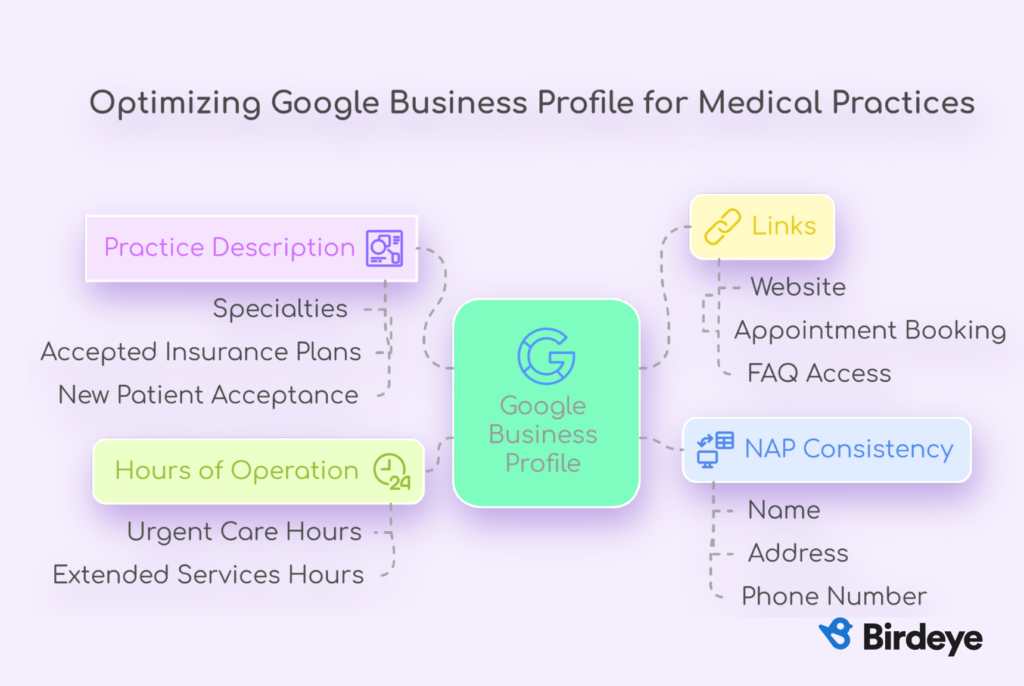
To start, your Google Business Profile should include:
- A clear description of your medical practice, including specialties, accepted insurance plans, and whether you’re accepting new patients.
- Accurate hours of operation, especially for urgent care or extended services.
- Links to your practice website, appointment booking page, and access to frequently asked questions.
- A consistent name, address, and phone number (NAP) across all web listings — mismatches can hurt your local SEO rankings.
Add location-based keywords (e.g., “family physician in Tacoma” or “women’s health clinic near Austin”) to your business description and web page content to improve your search engine rankings. These small actions compound over time, moving your clinic closer to the top of local search results, especially for multi-location organizations where local visibility across all service areas is so important for new patients to find you.
Showing up in search is step one — but your reputation is what gets patients to click. Let’s talk about how to build that trust using online reviews.
2. Build trust through consistent, authentic patient reviews
Even when your medical practice ranks high in search, patients don’t just book the first provider they see — they compare reviews. Patient reviews aren’t just a reflection of service quality; they’re a trust signal. And in healthcare, trust drives decisions.
That’s why review generation and management are critical parts of any medical marketing strategy. But collecting feedback can’t feel like an afterthought — it needs to be built into the patient journey. Use automated, HIPAA-compliant systems to request reviews shortly after visits.
Platforms like Birdeye, a HIPAA-compliant organization trusted by thousands of providers, simplify this by sending secure, timely review requests via email or text.
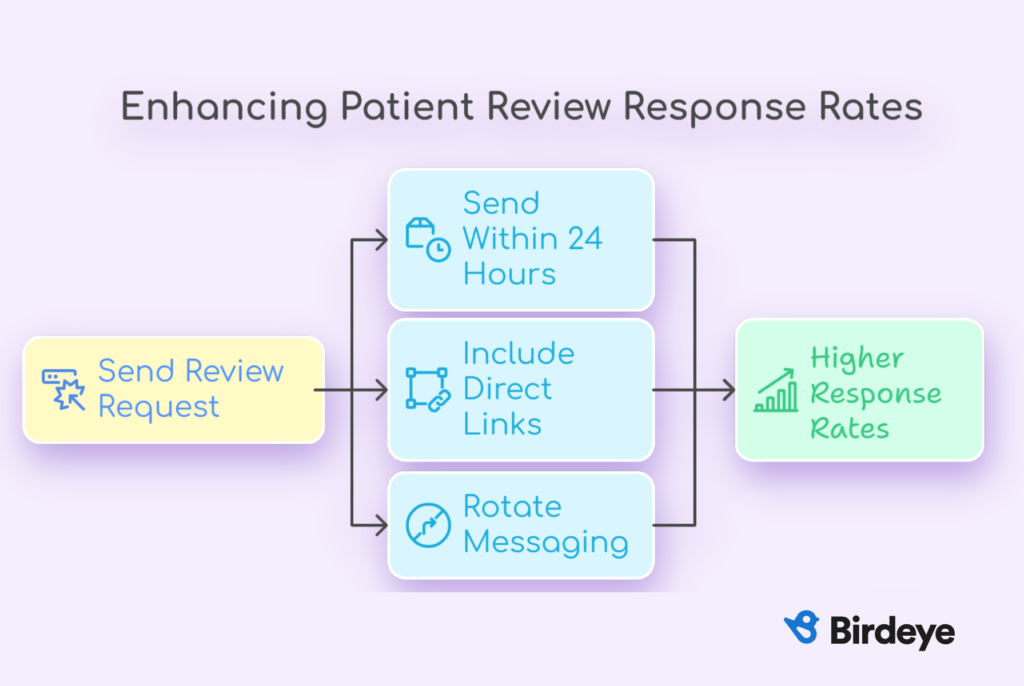
You’ll see higher response rates when you:
- Send requests within 24 hours of the appointment
- Include direct links to your Google Business Profile, Healthgrades, or Zocdoc
- Rotate your messaging so patients aren’t receiving the same prompt repeatedly
Don’t just focus on volume. Reviews that mention bedside manner, wait time, or provider empathy speak volumes to prospective patients deciding between healthcare providers.
Equally important is how you respond. A short, professional reply — even to critical feedback — demonstrates care and credibility. Avoid referencing treatment details to stay compliant, and always thank the patient for sharing their experience. This builds trust while protecting patient privacy.
Feature positive healthcare reviews across your practice website, social media channels, and search profiles. When prospective patients see others like them sharing positive experiences, your practice becomes the obvious choice, not just one of many. You’re not just collecting feedback — you’re developing a doctor’s reputation management system that patients trust.
Once trust is earned, the next challenge is keeping patients engaged — and that’s where helpful, educational content makes a real difference.
3. Use content to answer the questions patients haven’t asked yet
Most patients don’t start by calling your front desk — they start with questions. “Is my fatigue normal?” “What does a skin tag look like?” “Do I need to fast before my bloodwork?” Your practice can be the one that answers them — before they ever book.
This is where content-led digital marketing strategies come in. By sharing informative content tailored to what your target audience is searching for, you build authority and drive organic traffic from real potential patients.
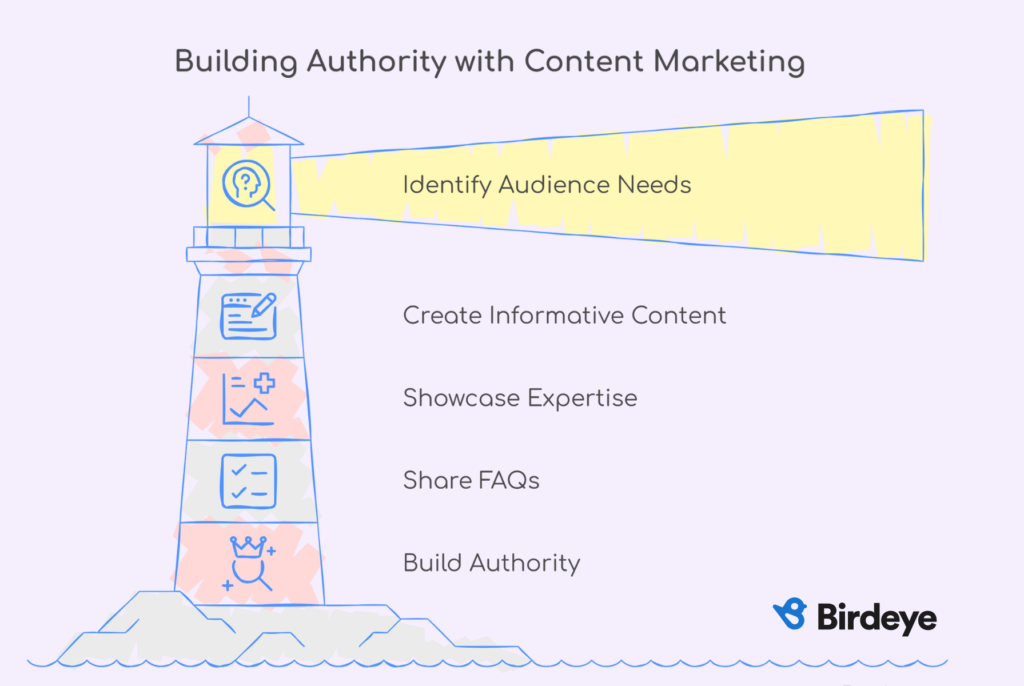
Here’s how to approach it:
- Publish blog posts and videos that address seasonal illnesses, symptoms, and common concerns.
- Create explainer content that showcases your expertise in key services or specialties.
- Share FAQs for first-time visits, insurance, or lab prep.
This kind of medical marketing doesn’t just inform — it builds patient confidence. It also fuels better voice search engine rankings by keeping your practice website active, relevant, and crawlable.
Bonus tip: Repurpose this content across social media platforms, email campaigns, and waiting room screens. For multi-location medical practices, standardizing content topics while tailoring them to local audiences can help turn your practice into a trusted resource, not just a place to visit when something’s wrong.
Once patients are reading your content, keep the relationship going with simple, helpful communication — straight to their inbox or phone.
4. Send emails and texts that patients find helpful
Marketing emails don’t have to be promotional — they just need to be useful. Most healthcare professionals already have patient contact info, but few use it strategically. That’s a missed opportunity to engage both current patients and prospective patients with content they’ll actually read.
The best email marketing in the healthcare industry focuses on clarity, not clicks. Think:
- Seasonal health reminders (e.g., flu shots, allergy care)
- Annual checkup recalls based on visit history
- Policy or hour changes for your medical office
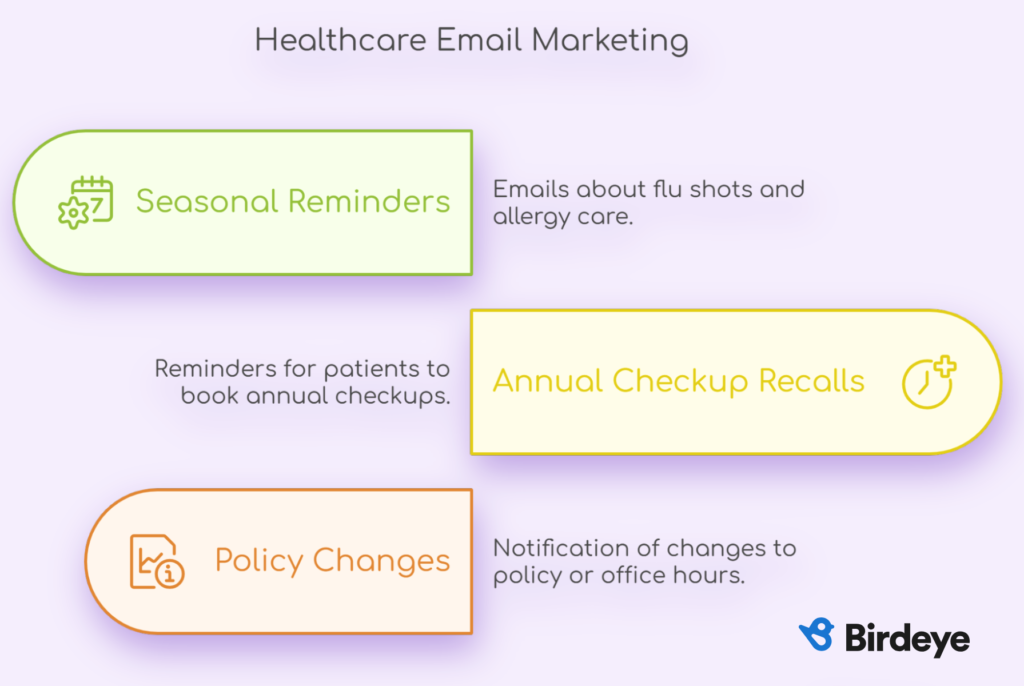
Text messages work well for no-show reduction and last-minute openings, especially when tied to your EMR or scheduling system.
Use segmentation to personalize by specialty (e.g., pediatric vs. geriatric care) or patient need. When done right, these small nudges reduce churn, increase return visits, and support the patient journey, without sounding like advertising.
Emails and texts keep patients informed — but your online presence also needs to feel human. That’s where social media becomes part of your broader medical marketing strategy.
5. Connect with your community on social media — thoughtfully
Social media marketing isn’t just for retail or restaurants. It’s an essential part of online marketing for doctors’ offices, especially when patients want to see the people behind the practice. That said, medical professionals don’t need to post daily or go viral — they just need to be visible, consistent, and respectful of patient boundaries.
Here are a few ideas that work well for healthcare practices:
- Introduce new physicians or spotlight staff members
- Share seasonal health tips (e.g., hydration during heatwaves or cold symptoms vs. flu)
- Post behind-the-scenes stories or community outreach moments
- Celebrate milestones like clinic anniversaries or new services
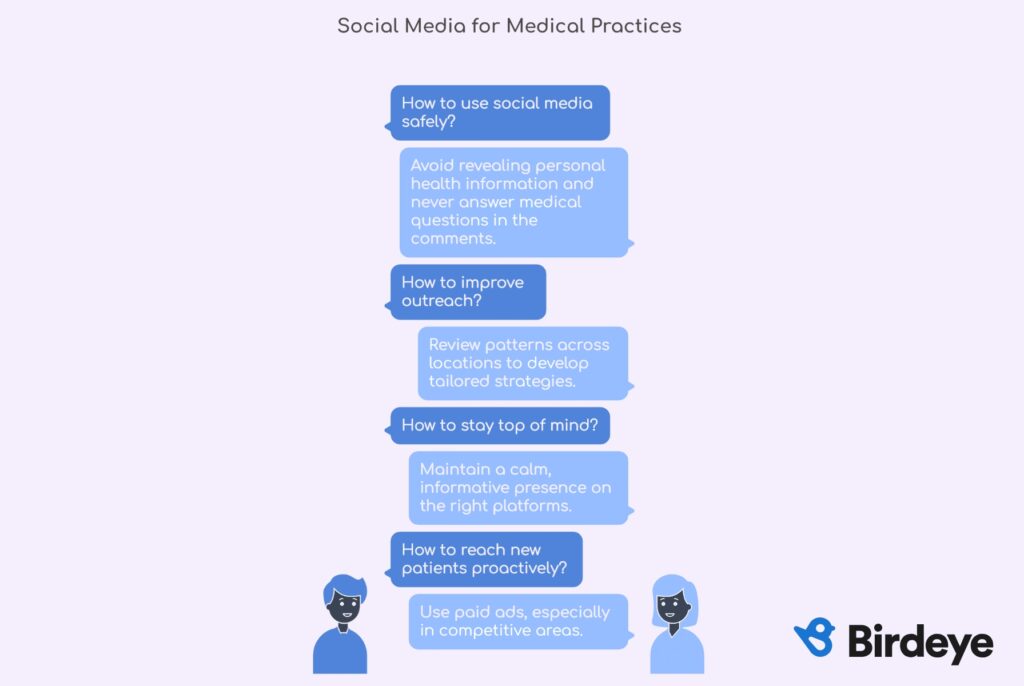
Avoid anything that could reveal personal health information — even indirectly. Use disclaimers when sharing general health guidance and never answer medical questions in the comments.
Reviewing patterns across locations helps develop smarter outreach strategies tailored to each community. So, by having the correct social media management presence, your medical practice stays top of mind, even when patients aren’t actively seeking care.
While organic content builds trust, sometimes you need to take a more proactive approach to get in front of new patients — especially in competitive areas. That’s where paid ads come in.
6. Run ads that target real patient needs, not generic impressions
Not all advertising works for medical practices, especially when it’s broad, brand-focused, or disconnected from what potential patients search for. The most effective campaigns focus on solving immediate needs and driving action.
For example:
- Use Google Ads to target searches like “dermatologist near me open Saturday” or “walk-in clinic for sore throat.”
- Run location-based Facebook or Instagram ads to reach prospective patients new to the area or looking for services you offer.
- Promote a specific service (e.g., same-day appointments or flu shots) rather than your practice overall.
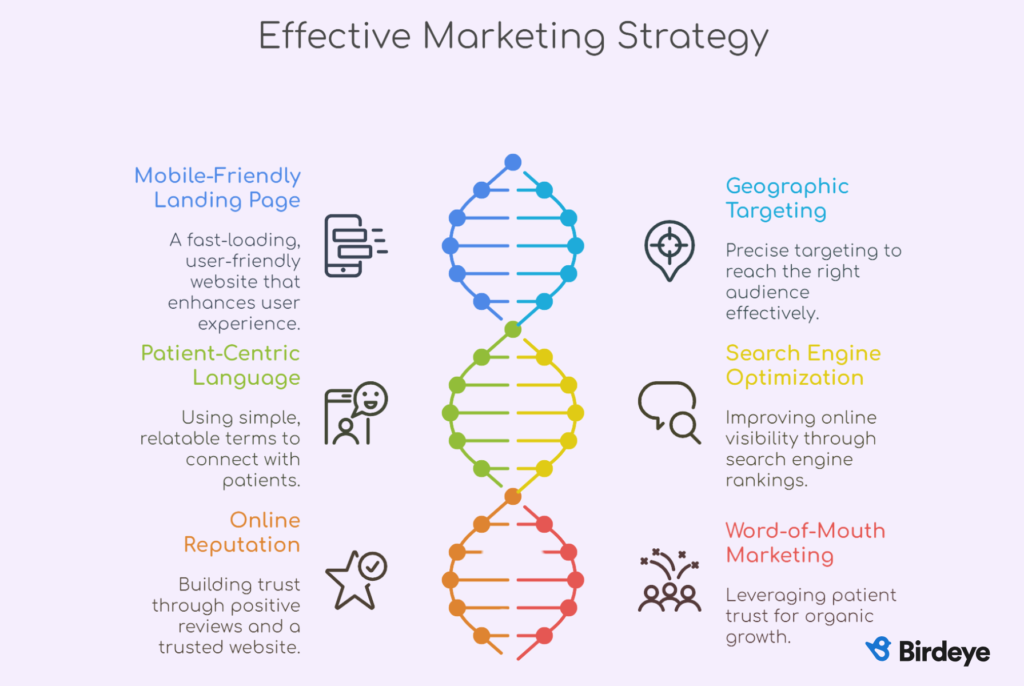
Pair these ads with a fast-loading, mobile-friendly landing page with services, availability, and appointment booking.
Use tight geographic targeting and avoid using medical terms patients wouldn’t type. Multi-location healthcare groups can run regional ad variations tied to location-specific services or seasonal needs to drive better local conversions. Think like your patient, not like a provider.
And remember: Paid campaigns work best when paired with strong search engine rankings, online reviews, and a trusted practice website. Ads get attention, but your reputation drives long-term success.
Speaking of reputation — sometimes your best marketing isn’t digital at all. It comes directly from patients who already trust you.
7. Turn happy patients into referral advocates — without sounding promotional
Most medical practices don’t ask for referrals — not because they don’t want them, but because they don’t want to seem pushy. But satisfied current patients are often your most persuasive marketers — you just need to create space for them to share.
Here’s how to improve patient satisfaction organically:
- Include a subtle referral mention in your email marketing (e.g., “Know someone who needs care? We’re accepting new patients.”)
- Use signage in your waiting area or after-visit handouts thanking patients for spreading the word
- Let patients know they can leave a review or share your info with family — it builds community, not sales pressure
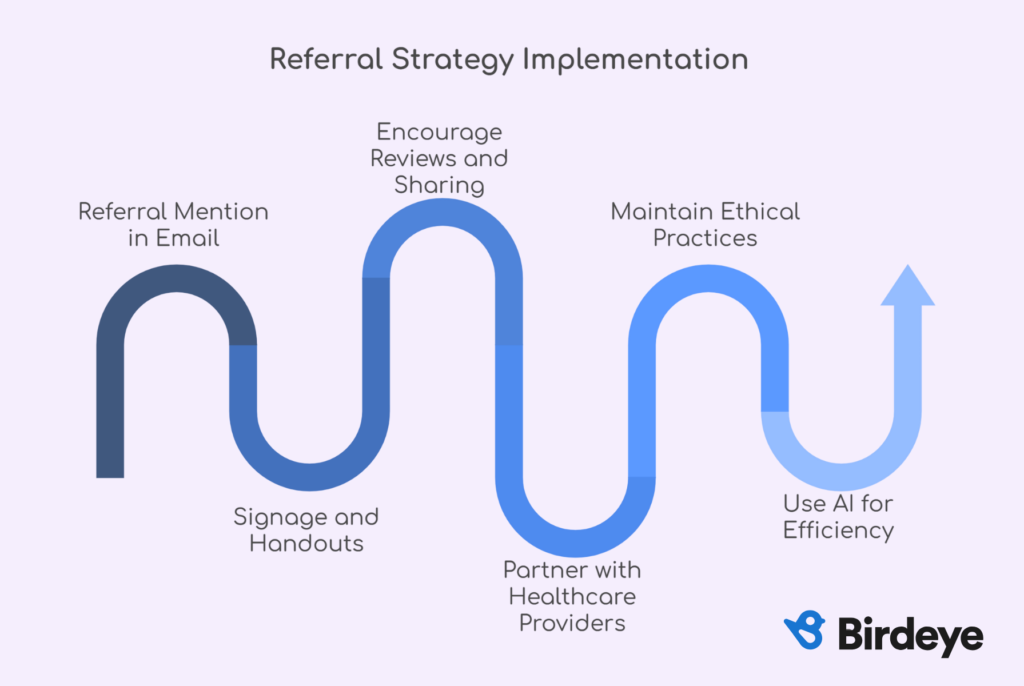
You can also partner with nearby healthcare providers or local physicians for cross-referrals. For example, a primary care clinic might collaborate with a podiatrist, therapist, or dietitian to keep referrals in-network.
The key? Keep it ethical, helpful, and human. Referrals built on trust, not incentives, are the most sustainable way to grow your patient base.
Want to make this referral loop — and every other part of your outreach — more efficient? Healthcare marketing automation can help streamline the work while preserving the human touch.
8. Automate outreach and reputation management with Birdeye GenAI
For many medical professionals, marketing often takes a back seat to patient care — and understandably so. But letting important marketing efforts fall through the cracks means fewer new patients, slower growth, and inconsistent visibility.
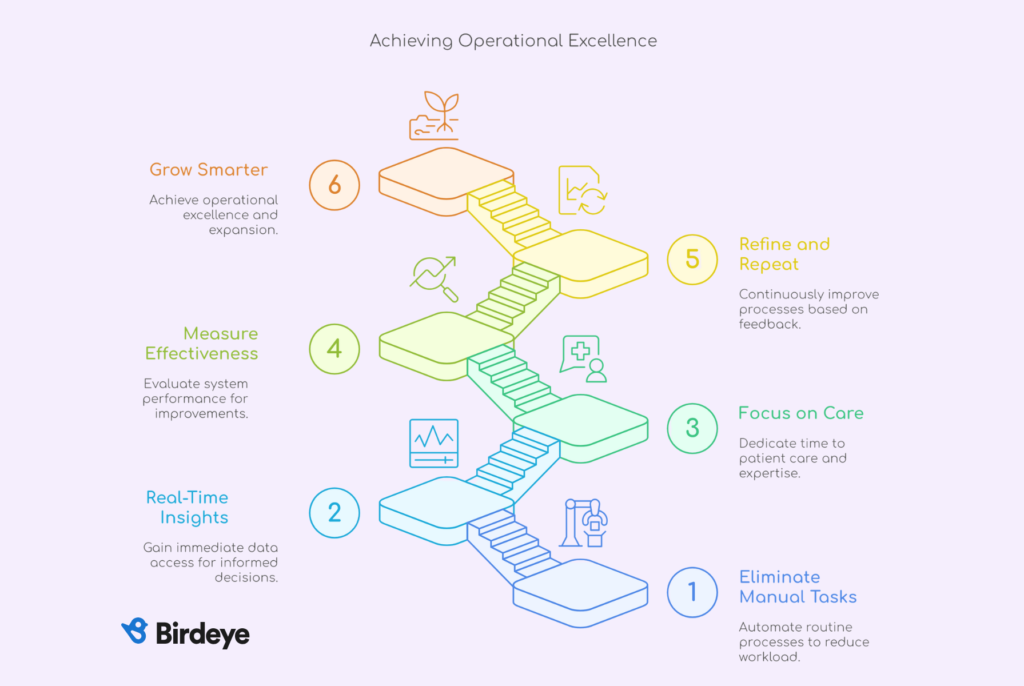
That’s where automation makes a real difference. Birdeye is an AI company that helps healthcare practices streamline marketing tasks like review generation, local listings, and patient communication — all in a HIPAA-compliant environment built for the healthcare industry.
Here’s what you can automate with Birdeye GenAI:
- Review requests after appointments via SMS or email
- Responses to patient feedback (with tone control and HIPAA safeguards)
- Social post generation and performance insights across social media platforms
- Monitoring listings and performance across search and review channels
By eliminating manual tasks and offering real-time insights, Birdeye helps your team stay consistent, without stretching thin. Whether you run a solo medical office or manage multiple locations, automation frees you to focus on what matters: delivering care with expertise and empathy.
Quick Care Med set new standards in medical marketing strategy with Birdeye
Quick Care Med — a fast-growing provider with nine clinic locations — knew that delivering quality healthcare services wasn’t enough. Their team of physicians was doing excellent clinical work, but outdated marketing systems were limiting their ability to reach potential patients.
Listings were inconsistent, Google Business Profiles optimization wasn’t correct, and review requests had to be managed manually—a serious disadvantage in today’s digital marketing landscape.
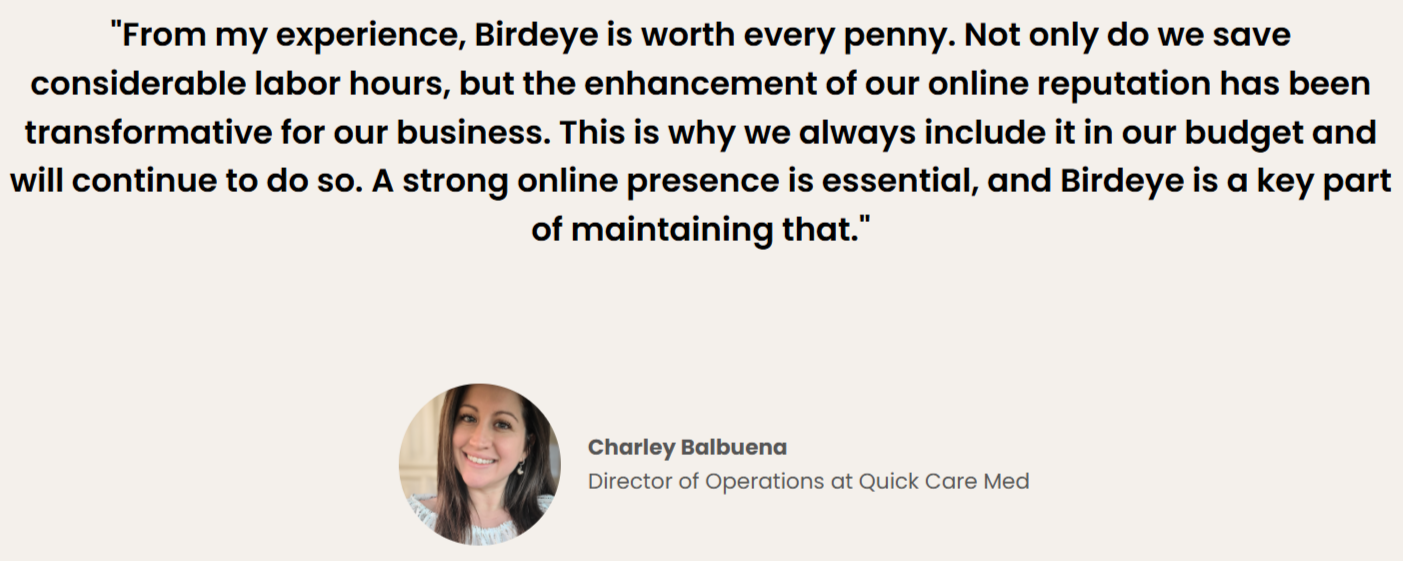
They realized that to grow sustainably, they needed a more unified medical marketing strategy — one that could help them get discovered, build trust, and convert online interest into booked appointments.
The challenge
Their decentralized online presence meant each clinic location was effectively marketing in isolation. With patients searching for care online more than ever, Quick Care Med lacked the tools to:
- Automate reviews across all nine offices
- Improve local SEO for doctors and visibility in search results
- Respond quickly to online inquiries across channels
The solution
Quick Care Med partnered with Birdeye to implement digital marketing strategies tailored to the healthcare industry. Using Birdeye’s GenAI tools — including Listings AI, Reviews AI, and Chatbot AI — they were able to:
- Sync business listings across Google, Facebook, and 50+ directories
- Automate the collection and response of patient feedback
- Streamline inbound business communication
- Execute scalable medical marketing without adding an administrative burden
The results
The payoff was immediate and measurable. Their new marketing strategies led to:
- 98.5K Google Maps mobile impressions — a direct lift in local search traffic
- 94.7K call clicks from Google Business Profile listings
- 15.3K verified reviews averaging 4.6 stars
- A 24.7K boost in Facebook engagement, driven by consistent social media marketing
- 81.18% of all website traffic now originates from Google

They didn’t just reach more patients — they also strengthened their reputation with job-seeking providers. Many physicians cited Quick Care Med’s online presence and positive reviews as a deciding factor when applying.
This is what successful medical marketing looks like: integrated systems, better data, and fewer manual tasks — all leading to real business outcomes.
If you’re looking to improve your own marketing for doctors offices, Quick Care Med’s approach offers clear tips: create consistent business listings, collect and showcase real reviews, and use automation to scale your visibility — without sacrificing quality care.
9. Use marketing analytics to improve decision-making and patient satisfaction
Many healthcare practices launch marketing campaigns but never track what’s driving results. Without clear data, you end up guessing, and it can cost money and time and cause the loss of new patients.
Analytics solves that. By tracking how patients find you, where they drop off, and what messaging resonates, you can confidently refine your digital marketing strategy.
Start by monitoring:
- Website traffic and top-performing pages (e.g., services or provider bios)
- Click-through rates on emails, ads, and appointment buttons
- Online reviews volume and sentiment trends
- Source attribution: Did patients find you via search, ads, social, or referral?
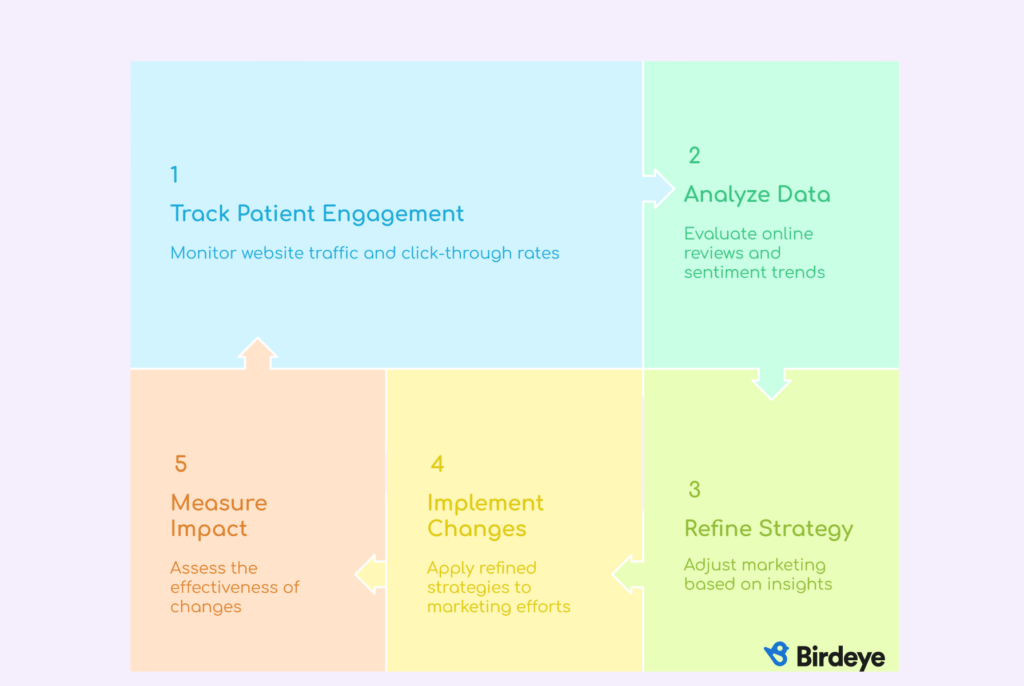
Multi-location operators can use centralized dashboards to compare location performance, identify underperforming regions, and tailor campaigns accordingly.
Tools like Birdeye GenAI provide easy-to-read dashboards that combine this data across channels — from Google Business Profile analytics to review responses.
Analytics aren’t just for proving ROI. They turn marketing data into patient-focused knowledge your team can act on, making every dollar and hour spent on marketing strategies more intentional.
FAQs on marketing for doctors’ offices
Begin with local SEO, review generation, and an up-to-date Google Business Profile. These low-cost strategies quickly boost visibility and trust.
Yes — as long as emails don’t include personal health information. Appointment reminders, wellness tips, and general updates are safe.
1–2 times per week is enough. Focus on consistency and relevance over volume — highlight services, staff, or health awareness topics.
Use a HIPAA-compliant platform like Birdeye to automate review requests post-visit via SMS or email for higher response rates.
Yes — especially when targeting local searches and promoting high-demand services. Start small, track results, and adjust based on what converts.
Birdeye helps you grow your practice ethically with better marketing for doctors’ offices
Online marketing in healthcare isn’t just about getting noticed—it’s about earning patient trust, showing up in local searches, and communicating with empathy. That’s the foundation of marketing success and Birdeye’s healthcare-centric GenAI tools simplify the hard parts—from automating reviews to managing online visibility—helping you focus more on care and less on coordination.
Whether you manage a small clinic or a multi-location healthcare organization, Birdeye gives you the tools to grow ethically, efficiently, and patient-first while delivering clear benefits.

Originally published









